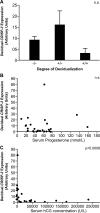Endometrial cysteine-rich secretory protein 3 is inhibited by human chorionic gonadotrophin, and is increased in the decidua of tubal ectopic pregnancy
- PMID: 19282327
- PMCID: PMC2666224
- DOI: 10.1093/molehr/gap019
Endometrial cysteine-rich secretory protein 3 is inhibited by human chorionic gonadotrophin, and is increased in the decidua of tubal ectopic pregnancy
Abstract
Ectopic pregnancy (EP) remains a considerable cause of morbidity and occasional mortality. Currently, there is no reliable test to differentiate ectopic from intrauterine gestation. We have previously used array technology to demonstrate that differences in gene expression in decidualized endometrium from women with ectopic and intrauterine gestations could be used to identify candidate diagnostic biomarkers for EP. The aim of this study was to further investigate the decidual gene with the highest fold increase in EP, cysteine-rich secretory protein-3 (CRISP-3). Decidualized endometrium from gestation-matched women undergoing surgical termination of pregnancy (n = 8), evacuation of uterus for miscarriage (n = 6) and surgery for EP (n = 11) was subjected to quantitative RT-PCR, morphological assessment, immunohistochemistry and western blot analysis. Sera were analysed for progesterone and human chorionic gonadotrophin (hCG) levels. Immortalized endometrial epithelial cells were cultured with physiological concentrations of hCG. CRISP-3 mRNA and protein expression were greater in endometrium from ectopic when compared with intrauterine pregnancies (P < 0.05). CRISP-3 protein was localized to epithelium and granulocytes of endometrium. CRISP-3 serum concentrations were not different in women with ectopic compared with intrauterine pregnancies. CRISP-3 expression in endometrium was not related to the degree of decidualization or to serum progesterone levels. Endometrial CRISP-3 expression was inversely proportional to serum hCG concentrations (P < 0.001). Stimulation of endometrial epithelial cells with hCG in vitro caused a reduction in CRISP-3 expression (P < 0.01). The measurement of CRISP-3 in endometrium could provide an additional tool in the diagnosis of failing early pregnancy of unknown location. The absence of a local reduction in expression of CRISP-3 in decidualized endometrium of women with EP may be due to reduced exposure to hCG due to the ectopic location of the trophoblast.
Figures






References
-
- American Society for Reproductive Medicine. Medical treatment of ectopic pregnancy. Fertil Steril. 2006;86:S96–S102. - PubMed
-
- Ball E, Bulmer JN, Ayis S, Lyall F, Robson SC. Late sporadic miscarriage is associated with abnormalities in spiral artery transformation and trophoblast invasion. J Pathol. 2006;208:535–542. - PubMed
-
- Birkhahn RH, Gaeta TJ, Paraschiv D, Bove JJ, Suzuki T, Katoh H, Nagai R. Serum levels of myoglobin, creatine phosphokinase, and smooth muscle heavy-chain myosin in patients with ectopic pregnancy. Ann Emerg Med. 2001;38:628–632. - PubMed
-
- Bjartell A, Johansson R, Björk T, Gadaleanu V, Lundwall A, Lilja H, Kjeldsen L, Udby L. Immunohistochemical detection of cysteine-rich secretory protein 3 in tissue and in serum from men with cancer or benign enlargement of the prostate gland. Prostate. 2006;66:591–603. - PubMed
-
- Corker CS, Davidson DW. A radioimmunoassy for testosterone in various biological fluids without chromatography. J Steroid Biochem. 1978;9:373–374. - PubMed
Publication types
MeSH terms
Substances
Grants and funding
LinkOut - more resources
Full Text Sources
Other Literature Sources
Medical

